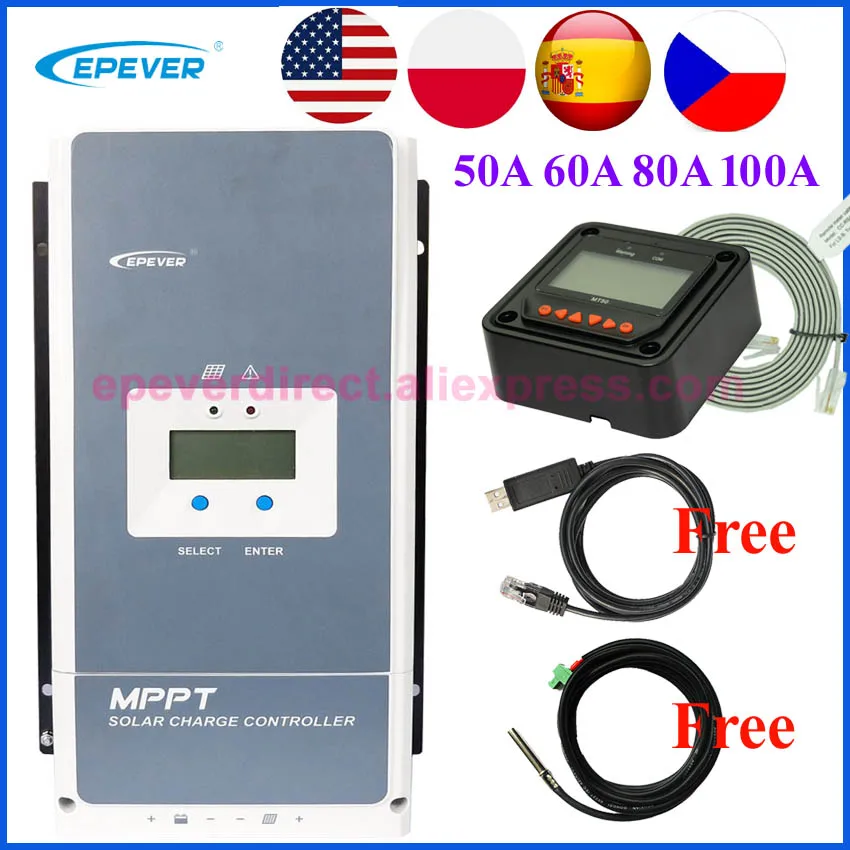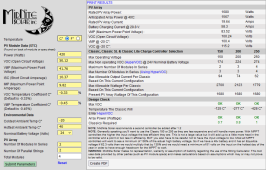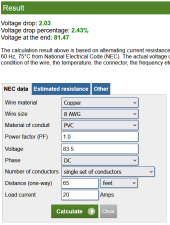off.the.grid
New Member
- Joined
- Dec 26, 2021
- Messages
- 124
OK, im forgetting about the current, so this would stack up fairly high with a roof of panels.Mostly in voltage drop between the panels and the SCC is where you see the difference. Putting a lot of panels in parallel adds up the amperage from each panel, so by the time you've got a few panels out there you've got to have thick expensive wire between the two to avoid too much voltage loss from the length of wire. When you run in series you're only putting through the amperage of a single panel but you're doing it at a much higher voltage. Since wire diameter is based on amperage, the wire is MUCH thinner and cheaper to pump 5a across than 50a across.
For example, using 10 bog standard 100w panels at 20VoC and 5a each the math looks something like this:
10 in series is 200v at 5a. If you run a 14AWG wire you might see 3% loss. 3% of 200 is squat.
10 in parallel would be 20v at 50a which is a FAT expensive wire. Now you're 3% loss is from 20v which is much more significant.
10 in Series/Parallel in a 5s2p system would get you 100v at 10a which would save you a good chunk of money still and allow you to aim your strings in different directions if you want and that voltage drop is still well under control.
As long as the SCC can handle the higher voltage, you'll net more power running in series with a lower voltage drop over distance and not have to re-mortgage the house to afford the copper. The biggest key here is the math for your panels. Use the VoC number when calculating how many you could put in series and give yourself some wiggle room because panel voltage increases a bit when the panels get really cold.
The major down side to running in series is that if you have a string of panels and a shadow from a tree branch or dark cloud or sleeping cat or leprechaun butt or something covers even 1 panel in the string, that whole string takes a MAJOR hit in performance. That's one of the reasons a lot of people prefer to do multiple strings in parallel. If one string gets shaded, the other strings can still be working fine. You get the advantages of higher voltages to save on wire AND the redundancy to help with any shading issues.
I was thinking this was really only a big issue at lower voltages like 12V or something.
So the advice seems to go with 4 of these 420W panels, 2S2P, and feed them into a 60A controller, (the recommended epever controller looks like a good one)
How long could I realistically run the cables to the controller from the panels?
I was thinking of putting the new ones on the hill behind the garage so they are easier to access and mount in the correct position. We would need about 20M of cable from the panels at a rough guess.
The current panels are not even mounted true north, they are kinda pointing north east and need to be shifted almost 45 degrees to get sun all day, by 4PM, the sun was shining behind the panels!
The 420W panels im looking at give almost 10A of current each, which is 100V @20A max if i wire them in 2S2P.
Sorry, I was referring to the 12V controller for the wind turbine, ive disconnected it until I can find out what type of turbine and/or controller it uses. It seems to spin very fast in high wind, so there is likely no dummy load installed.Throw the 12V controller away. Get yourself a good MPPT controller. Pay attention to both the maximal voltage and maximal amperage while shopping.
Yes your right, its a 24V model specifically, but it comes in different configurations, for some reason I thought that it could be wired depending on your battery configuration. I would expect shipping such batteries to NZ would be expensive, there does seem to be a good amount of solar suppliers here importing all this stuff, but ive found things such as the charge controller cheaper on aliexpress thats identical to what is sold here. I will end up buying it directly from China because its not only cheaper, but out of stock from the NZ suppliers.NO, you have a 24v inverter, so you need a 24V battery bank. But, there are many, many high capacity battery options. That being said, I'm in the US, and the shipping options all the way across the Pacific may be more limited. I myself have 568Ah Canadian batteries, delivered right to my driveway. I'm guessing that's not likely to happen in NZ?
Yes im aware of the BMS in lithium batteries, but I thought that was only to manage the charging of the batteries, does not each cell still interact with each other in an undesirable way when you have so many? Obviously it works fine in a tesla for example, ive never really looked much into how BMS systems work, but i expect they are more than just individually charging each cell. With lead acid batteries, I guess its not really a thing since each cell delivers so much more current than a tiny cylindrical lithium cell.Li ,batteries typically have a built-in battery management system, or BMS, which controls battery performance. Plain old lead-acid batteries just get wired in series and you're done.
OK, i will ignore it. Have been reading pages of stuff this last week and assumed it was a thing that was done.
I would skip the gimmicky strategies completely. I think RNT gave a very good explaination of both why series panels are good and also how a battery should be wired.
Still trying to work out if i need circuit breakers going between the panel and the charge controller.
Its a weird way how they are configured on my setup, I need to draw a schematic, but basically each end (positive and ground) is going through a circuit breaker to the controller.
OK, thats good to know, so rapid bubbling should not necessarily mean you are going to go through more water than necessary?Rapid bubbling is a good thing. It keeps the battery acid mixed and prevents statification. The big enemy of lead-acid batteries is chronic undercharging. Get them fully charged each and every day, and you will have many years of service. I upgraded my own GC batteries after 5 years of service. I gave them to a neighbor instead of recycling them because they still had lots of life in them. Remember, under-charged lead batteries die a quick death.
The controller in theory would stop charging once it detects that the batteries are full to prevent overcharging?
Well, no. Even with the newest, most sophisticated electronics, you still have to watch the water levels. But, I check maybe once a month, and then add water maybe every two to three months. I'd say watch your system closely for the first couple of months till you are comfortable your rate of water loss. Just leave a jug of distilled water handy at all times. Remember, distilled water ONLY.
Yes, the owner left me a container of distilled water, this is something that many people often forget with batteries. Especially now that more car batteries are becoming maintainance free.
Looks like I wont need to go through anywhere near as much water as before, but will keep an eye on it.
This should be determined by the battery manufacturer. Look up your battery on their spec sheet/webpage and see what charging parameters they specify. My manufacturer is Rolls/Surrette and they recommend a range of 2.45-2.50V per cell. With 12 cells per 24V battery that range works out to be 29.4V to 30.0V. Right now I've got my charge controller set to 29.6V, which seems to balance getting the batteries fully charged, without consuming too much water.
I believe your generator power is being passed through your inverter, so most likely, there's a menu item you can go to to adjust charging voltage. A new MPPT charge controller will definately be voltage adjustable. Look up the charging rate for YOUR battery and set the voltage charging parameter to that. Remember, there may be different voltages for bulk charging, vs absorb, vs floating.
OK, i will do that. My current MPPT controller has some jumpers to change voltages which im assuming are factory preset profiles.
The inverter charger has some pots on the front that can be tweaked. I guess this would be super easy to adjust with a screwdriver and check with my multimeter.






